![[Agriculture.]](img-thumbnail/jpegs/50428.jpg)
[Agriculture.]
B. West R.A. Historical Painter to his Majesty pinx.t. F. Bartolozzi Historical Engraver to his Majesty sculp.t.
[London Published as the Act directs Oct.r 1789 by B. West, Newman Street.]
Oval etching. Printed area (at most) 515 x 640mm (20¼ x 25¼"). Framed. Unexamined out of frame, probably trimmed within plate, losing publication line?
An idyllic harvest scene, with figures cutting corn with sickles, binding sheaths, gathering grapes and plouching with oxen. One of nine designs by Bartolozzi for the ceiling of the Queen's Lodge at Windsor, which was pulled down in 1823 by George IV. De Vesme 1331.
[Ref: 50428] £1,200.00
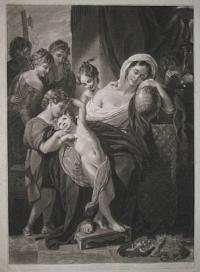
Agrippina, surrounded by her Children, weeping over the Ashes of Germannicus.
B. West R.A. pinxit, 1773, London. V. Green, Engraver in Mezzotinto to his Majesty Fecit. From the Original Picture in the Possession of A. Vesey.
Publish'd by J. Boydell, Cheapside July 23. 1774.
Mezzotint, very rare open letter title, 610 x 430mm. 24 x 17". Margin with tears, one just into plate at right.
The widow Agrippina, seated, mourns with her head resting against an urn inscribed with her husband Germanicus’s name, comforted by one of her daughters, who touches her neck. A naked boy stands at her feet, leaning back with his hand on his brother's head; behind two young women stand, their arms around each other. A young man beside them buries his head in his hands, another son at the left bows his head; a crown, laurels and a statue of an eagle in the right foreground. In 5 AD Agrippina married Germanicus, her second cousin and step-grandson of the Emperor Augustus. Agrippina had nine children by Germanicus, including the future emperor Gaius (Caligula). Agrippina was very popular among the Roman people, not least because of her marriage to the much-loved Germanicus, whose ashes she brought back to Rome after his death in the east in AD 21. Her strength and popularity aroused the suspicions of the emperor Tiberius and his right-hand man Sejanus, head of the Praetorian guards and she and her eldest son were banished to the Pontian islands on the Bay of Naples in AD 29. Four years later, following a beating so severe that she was blinded in one eye, Agrippina starved herself to death. Her popularity, however, ensured a decent burial, and she was laid to rest at Rome in the Mausoleum of Augustus.
After Benjamin West (1738 - 1820). Whitman: 180, II of II. Chaloner Smith: undescribed. Ex: Collection of The Hon. C. Lennox-Boyd.
[Ref: 14844] £360.00
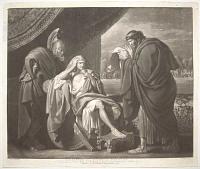
Alexander and Philip His Physician. From the Original Picture Painted by Mr Benjamin West; In the Collection of G.Stibbert Esq.r.
B.West pinxit. Val: Green fecit.
Published Jan.y 1st 1772 by John Boydell Engraver, in Cheapside London.
Scarce mezzotint, 440 x 525mm (17¼ x 20¾"), on 18th century watermarked paper. Nicks and repaired tears on large margins.
Medical interest. Alexander the Great in his tent, nursing his head. Ex Collection Hon. C. Lennox-Boyd Whitman: 171
[Ref: 60336] £490.00
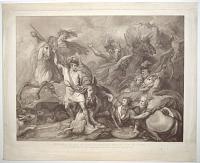
Alexander III. King of Scotland Rescued from the Fury of a Stag by the Intrepidity of Colin Fitzgerald, the Ancestor of the Present Mackenzie Family.
B. West pinx. F. Bartolozzi, sculp 1788.
Stipple, printed in sepia, faint watermark. 565 x 715mm (21¾ x 28¼") with very wide margins. Damage to margins, margin rebuilt in the top left corner.
Colin Fitzgerald pulls the antler of a stag and raises his spear to kill it. Other huntsmen rush to the aid of the fallen king. Alexander (1241-86) may have survived this episode, but he died aged 44 falling from a horse. His heir was his granddaughter, Margaret, Maid of Norway, but she died before she could be crowned, leaving the throne of Scotland to John Balliol.
[Ref: 52663] £390.00
![[Apollo calling up the Fine Arts and Sciences.]](img-thumbnail/jpegs/50427.jpg)
[Apollo calling up the Fine Arts and Sciences.]
B. West inv.t Historical Painter to his Majesty, R.A. F. Bartolozzi sculp.t Historical Engraver to his Majesty.
[London Published as the Act directs Oct.r 1789 by B. West, Newman Street.]
Oval etching. Sheet 530 x 660mm (21 x 26"). Framed. Trimmed within plate, losing publication line?
Apollo alighting, torch in hand and wings spread, gesturing towards allegorical figures of the arts and sciences. Half-hidden is a bas-relief of George III. One of nine designs by Bartolozzi for the ceiling of the Queen's Lodge at Windsor,which was pulled down in 1823 by George IV. De Vesme 557.
[Ref: 50427] £2,000.00
![[Annonce de T. Sandby.]](img-thumbnail/jpegs/20501.jpg)
[Annonce de T. Sandby.]
B. West R.A. inv. 1791. F. Bartolozzi R.A. etched.
London Publish'd May 1791. by Mr. Sandby Jun.r St. Georges Row.
Etching and engraving, very scarce and fine. Plate 241 x 165mm. 9½ x 6". Crease to bottom right-hand corner, small margins, overall foxing.
Trade card for Thomas Sandby, depicting the daughter of Dibutades embracing her lover and outlining his shadow on the wall, while he holds a lamp on the left. Thomas Sandby (1721-1798) was a self-taught draftsman who, with his brother Paul took up positions in the military drawing department at the Tower of London. Thomas was sent first to the Battle of Dettingen and then to Culloden as draughtsman to the Duke of Cumberland. In 1747, under the Duke, he was appointed Deputy Ranger of Windsor Great Park to which he devoted considerable energy in improvements. He was also involved in the London art world and with his brother he was one of the founder members of the Royal Academy in 1768. He was elected their first professor of architecture and later architect of the King's works. In reality, he built few buildings and was more respected for his architectural theory. De Vesme: 1892; ii/iii.
[Ref: 20501] £450.00
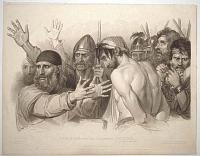
Barabbas with the Condemned Thieves. St. Luke chap. XXIII.v.XVIII.
Painted by Benj.n West, Esq.r P.R.A. Drawn by Henry Corbould. Engraved by Edward Scriven, Hist.l Engraver to The Prince Regent & the Princess of Wales. London: Published by T. Clay, N.o 18 Ludgate Hill, June 4; 1814.
London, 1814.
Rare stipple and etching. 375 x 475mm (14¾ x 18¾"). Trimmed to plate top, left and right edges. Some toning.
Barabbas and two other thieves are restrained and in cuffs, and appear to be surrounded by a number of soldiers in the background. According to the Synoptic Gospels, Barabbas, imprisoned for murder and insurrection against the Roman state according to Mark and Luke, was released by Pontius Pilate according to a Passover tradition whereby a prisoner could have their death sentence communted by popular demand. The story goes that the crowd of Jewish people ask for Barabbas's release, thereby condemning Jesus to death, though the plausibility of Barabbas's release is contested by some historians.
[Ref: 53952] £220.00
(£264.00 incl.VAT)
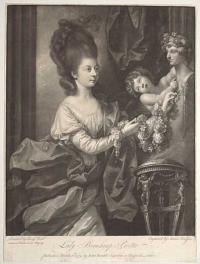
Lady Beauchamp Procter.
Painted by Ben. West Historical Painter to his Majesty. Engraved by James Watson.
Published March 25.th, 1779, by John Boydell Engraver in Cheapside. London.
Mezzotint, sheet 380 x 285mm (15 x 11¼"). Thread margins. Repairs.
Three quarter length portrait of Lady Mary Beauchamp Proctor (d.1847), wife of Sir Thomas Beauchamp Proctor, 2nd Baronet, (1756-1827). She is seen placing wreath of flowers on statue of Hymen, which a putto is clinging to. She wears a loose, flowing gown and her hair dressed high. In the background are pillars and curtains. CS 121.II
[Ref: 61690] £240.00
(£288.00 incl.VAT)
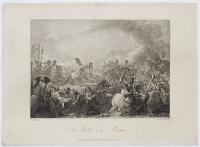
The Battle of the Boyne.
Painted by West. Engraved by J. Grozer.
London: Republished 1. May 1824 by Robert Wilkinson, No. 125 Fenchurch Street.
Rare aquatint with etching. On watermarked paper, 'J. Whatman'. Sheet size: 275 x 375mm (10¾ x 14¾"). Trimmed to platemark. Light creasing and scuffs.
A scene after Benjamin West, depicting William III in the centre, leading his army on horseback as they surge onto the banks of the River Boyne, where, in the lower left corner, the Duke of Schomberg, mortally wounded, is carried by four soldiers. The Battle of the Boyne took place in 1690 between the Catholic James II and the Protestant William III across the River Boyne near the town of Drogheda on the east coast of Ireland, resulting in a victory fo William III.
[Ref: 37321] £140.00
(£168.00 incl.VAT)
![[Battle of the Boyne.] To His Royal Highness George Prince of Wales, This Plate engraved from the original Picture of The Battle of the Boyne,](img-thumbnail/jpegs/54702.jpg)
[Battle of the Boyne.] To His Royal Highness George Prince of Wales, This Plate engraved from the original Picture of The Battle of the Boyne, in the Collection of the R.t Hon.ble the Lord Grosvenor Is by permission Dedicated by His Roal Highnesse's most faithful obedient Servants - Benj.n West and John Hill.
Painted by B. West, Historical Painter to His Majesty. Engraved by John Hall.
Published as the Act directs, 18 Oct.r 1781 by B. West, j. Hall & W. Woollett, London.
Etching with engraving, 18th century watermark. 485 x 615mm (19 x 24¼"). Trimmed to plate, some toning of paper.
William III on a white horse, leading his army across the Boyne, 1st July 1690. Bottom right the Duke of Schomberg is carried off by four soldiers, having been shot in the neck BM: 1876,0708.2600, final published state.
[Ref: 54702] £420.00
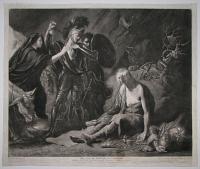
The Cave of Despair. From Spenser.
B. West, R.A. pinxit. Val. Green Engraver to his Mayesty, fecit.
Published, June 1st. 1775, by John Boydell Engraver, Cheapside, London.
Mezzotint, uncleaned title area, 445 x 530mm. 17½ x 20¾". Few stains.
Illustrates Edmund Spenser's (1552? - 1599) epic poem 'The Faerie Queene': Despair, an old man, sits in ragged clothing on the ground with instruments of suicide at his left hand, the corpse of Sir Terwin beside him and a skeleton on the rocks behind. To left the Red Cross Knight holds a dagger to his own neck as Una rushes to stop him, a donkey beside her. After the painting by Benjamin West (1738 - 1820). Whitman: 190. Chaloner Smith undescribed. Ex: Collection of The Hon. C. Lennox-Boyd.
[Ref: 14841] £450.00
![[St Cecilia.]](img-thumbnail/jpegs/20481.jpg)
[St Cecilia.]
Benjamin West inv. F. Bartolozzi sculpst.
London. Published Jany 1.st 1783, by A. Poggi.
Stipple and etching, fine. 204 x 190mm. 8 x 7½". Trimmed, and cut inside platemark
St Cecilia playing an organ, with a cherub standing by her right shoulder pulling on a rope. De Vesme: 2217; ii/iv. See Ref: 20448 for unknown cut state.
[Ref: 20481] £240.00
(£288.00 incl.VAT)
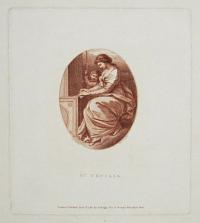
S.t. Cecilia.
Benjamin West inv. K. Bartolozzi Sculpsit.
London Published June 1.st 1784, by A: Poggi, No.7, St. Georges Row, Hyde Park.
Stipple, printed in sepia. Plate: 220 x 190mm (8¾ x 7½'') very large margins.
A portrait of Saint Cecilia, the patron saint of music, shown playing the organ. De Vesme 2217 III.
[Ref: 48293] £240.00
(£288.00 incl.VAT)
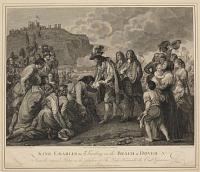
King Charles the 2nd Landing on the Beach at Dover. From the original Picture in the possession of The Right Honourable the Earl Grosvenor.
Painted by B. West Historical Painter to His Majesty. Etch'd by Will.m Woollett, Historical Engraver to His Majesty. Engraved by De Launay.
Published as the Act directs, by B. West, E. Woollett & J. Hall, London. [n.d. c.1815.]
Copper engraving. 310 x 362mm. 12¼ x 14¼". Trimmed and glued to backing sheet.
Charles II returning to England after exile, on the beach being greeted by General Monk, the Dukes of Gloucester and York, the Earl of Clarendon and Sir John Grenville and others, with Dover Castle in the background. After Benjamin West, American-born painter who succeeded Reynolds as President of the Royal Academy of Arts.
[Ref: 24356] £120.00
(£144.00 incl.VAT)
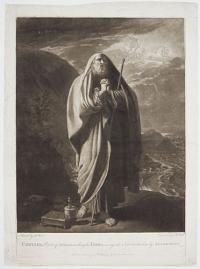
Chryses, Priest of Apollo, invoking his God to revenge the Injuries done him by Agamemnon. Hom. Il.d
Painted by B. West / Engrav'd by J.R. Smith
Publish'd March 1st 1774, by W.m Humphrey, Gerrard Street, Soho, London.
Scarce mezzotint, platemark 510 x 355mm (20 x 14"). Some creasing off image; repaired breaks along platemark.
During the Trojan War, Agamemnon abducted Chryses' daughter Chryseis and refused Chryses' attempts to ransom her (the gifts which Agamemon rejected lay on the floor). As shown here, Chryses then prayed to Apollo (seen here riding through the sky in his chariot) for revenge, which came in the form of a plague which befell Agamemnon's army. He was forced to return Chryseis in order to end it. The reunion of Chryses with his daughter was perhaps a common theme for artists of this period than the anguished invocation depicted here. Mezzotint by J.R. Smith published in 1774, the year after Benjamin West's painting was exhibited at the Royal Academy. The print was later republished by John Boydell. D'Oench 36 i/ii; Frankau 81. For Chryses reunited with his daughter, see refs. 18276 and 21858. Ex: The Hon. Christopher Lennox-Boyd.
[Ref: 38313] £650.00
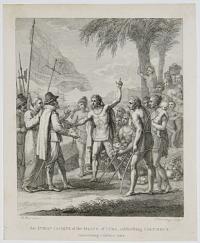
An Indian Cacique of the Island of Cuba, addressing Columbus concerning a future state.
B. West delin.t. F. Bartolozzi sculp.t.
[n.d., c.1794.]
Engraving. Sheet size: 230 x 195mm (9 x 7¾"). Trimmed inside plate.
A meeting between Christopher Columbus and a cacique (Taino for chief) and his people. Columbus is backed by a priest and some soldiers to the left. The natives appear to have an offering of fruit, including pineapples, shown on the right. After Columbus' arrival, Cuba became a Spanish colony, ruled by a Spanish governor in Havana. In 1762, Havana was briefly occupied by Great Britain, before being returned to Spain in exchange for Florida.
[Ref: 37611] £140.00
(£168.00 incl.VAT)
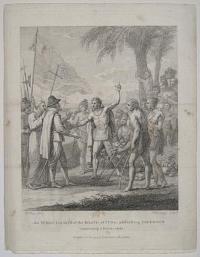
An Indian Cacique of the Island of Cuba, addressing Columbus concerning a future state.
B. West delint. F. Bartolozzi sculpt.
Publish'd Novr. 18, 1794 by I. Stockdale, Piccadilly.
Etching, 255 x 205mm (10 x 8"). Stained.
From the Capper Album.
[Ref: 10700] £70.00
(£84.00 incl.VAT)

[To the King's most excellent Majesty, This plate, The Death of General Wolfe, is with His gracious Permission humbly dedicated by his Majesty's most dutiful Subject, William Woollett. From the original Picture in the Collection of the Right honourable Lord Grosvenor.
Painted by B. West, Historical Painter to His Majesty. Engraved by W.m W[oollett, Engraver to his Majesty.]
Published as the Act directs January 1.st 1776. by Mess.rs Woollett, Boydell & Ryland, London.]
Engraving. Sheet 440 x 615mm (17¼ x 24¼"), with title excised but present, with separate engraved key of six personages. Trimmed to plate on three sides and to image at bottom.
Large engraving of Benjamin West's famous painting of 1770 (Ottawa, National Gallery of Canada) representing the death of the British General James Wolfe at the Battle of the Plains of Abraham in 1759 during the Seven Years' War. Despite Wolfe's death, the result of the battle was a decisive British victory. The composition deliberately evokes the Lamentation of Christ, a subject frequently depicted in religious painting. The people in the key Monckton, Col Williamson, Major Barré, Capt Debbing, Capt Hervey Smyth and surgeon Mr Adair.
[Ref: 49808] £420.00
view all images for this item
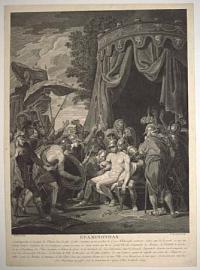
Epaminondas.
B. West pinx. P. Bernard Sclp.
[n.d., c.1780.]
Fine engraving. Sheet 575 x 440mm (22¾ x 17¼"). Trimmed within plate.
A French engraving of Benjamin West's 'The Death of Epaminondas', painted for George III in 1773. It shows the Theban general, wounded at the Battle of Mantinea (362 BC), sitting outside his tent, right hand on a spear-point in his side, as his physician is about to draw it out, knowing that it will kill him.
[Ref: 53903] £260.00
(£312.00 incl.VAT)
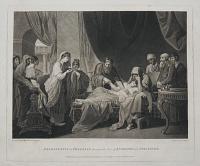
Erasistratus the Physician discovers the Love of Antiochus for Stratonice.
Painted by B. West, Hist.l Painter to his Majesty. Engrav'd by Geo.g Graham.
Publish'd June 24, 1793, by J. & J. Boydell, Cheapside, & at the Shakespeare Gallery Pall Mall London.
Stipple and etching. Plate 323 x 391mm (12¾ x 15½"). Some creasing. Backed. Repaired hole in title area.
King Seleucus sits in a melancholy pose, supporting the head of his son Antiochus who lies in bed, attended by his physician; the patient looks towards Stratonice, who stands at the foot of the bed with four female attendants; a further four onlookers stand solemnly at the right behind a table with crown and staff. Engraving after the 1772 painting by Benjamin West (Birmingham Museum of Art).
[Ref: 29954] £280.00
(£336.00 incl.VAT)
![[Fidelia and Spiranza.]](img-thumbnail/jpegs/14754.jpg)
[Fidelia and Spiranza.]
[Painted by B. West. Engraved by V. Green.]
[London: J. Boydell, 1778.]
Mezzotint, proof before all letters, uncleaned title area, 610 x 435mm. 24 x 17". Tatty and chipped margins. One tear into image at left.
Illustration of Edmund Spenser's (1552? - 1599) epic poem 'The Faerie Queene'. Two sisters descending steps, Fidelia at left in a white dress, a chalice from which a serpent emerges in her left hand and a large volume under her right arm. Through the arch at left Una, wife of Finnbheara, king of the Irish fairies, approaches on a donkey; a knight in armour on horseback rides alongside her. After Benjamin West (1738 - 1820). Chaloner Smith 160. Whitman: 207, unrecorded proof state. Ex: Collection of The Hon. C. Lennox-Boyd.
[Ref: 14754] £460.00
![George III. King of Great Britain. &c. &c. [&] Charlotte. Queen of Great Britain. &c. &c.](img-thumbnail/jpegs/36317.jpg)
George III. King of Great Britain. &c. &c. [&] Charlotte. Queen of Great Britain. &c. &c.
B. West pinx.t. C. Ruotte Sculp.t.
[n.d., c.1780.]
A Pair of Stipples. Sheet size: 250 x 160mm (9¾ x 6¼") each. Cut to platemark at sides.
A pair of stipple portraits after Benjamin West. King George III, bust, directed to right, within an oval. Queen Charlotte, bust, directed to front, looking left, hair dressed up, wearing a pearl necklace and a dress decorated in bows. George III (1738 - 1820) was King of Great Britain and Ireland from 25 October 1760 until the union of the two countries on 1 January 1801, after which he was King of the United Kingdom of Great Britain and Ireland until his death. On 8 September 1761 in the Chapel Royal, St James's Palace, the King married Princess Charlotte of Mecklenburg-Strelitz, whom he met on their wedding day. A fortnight later, both were crowned at Westminster Abbey.
[Ref: 36317] £120.00
(£144.00 incl.VAT)
view all images for this item
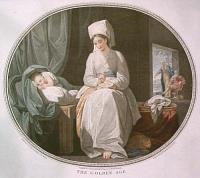
The Golden Age.
Painted by B.West Historical Painter to his Majesty. Engraved from the Original Picture by Facius.
Publish'd Jany 1st 1778 by John Boydell Engraver in Cheapside London.
Stipple, printed in colours. 295 x 330mm.
[Ref: 6517] £520.00
![The Golden Age. [&] The Silver Age.](img-thumbnail/jpegs/29074.jpg)
The Golden Age. [&] The Silver Age.
Painted by B. West, Historical Painter to his Majesty. Publish'd by J. Boydell, Engraver Cheapside, June 4.th 1777. Engraved by V. Green, Engraver to his Majesty, and to the Elector Palatine.
[&] Painted by H. Walton. Publish'd by J. Boydell, Engraver. Cheapside Jan.y 30.th 1778. Engraved by J.R. Smith.
Pair of framed mezzotints, extremely rare in matching contemporary frames. Visible area 470 x 559mm (18½ x 22").
Domestic scene in stylised Eastern setting; mother sitting to front and sewing, watching her sleeping young child beside her, old couple in doorway at right; oval format. [&] A circular frame with a little girl in a plain bonnet and cape, sitting in profile to left on a path with a basket of chickens beside her, a tree and high ground behind to the right, a town in a landscape below to the left. CS: 159. Whitman: 203. [&] CS: 198. Frankau: 320. Ex Collection: The Late Honourable Christopher Lennox-Boyd.
[Ref: 29074] £950.00
view all images for this item

The Golden Age.
Painted by B. West, Historical Painter to his Majesty. Engraved by V. Green, Engraver to his Majesty, and to the Elector Palatine.
Publish'd by J. Boydell, Engraver in Cheapside, June 4.th 1777.
Mezzotint with large margins; Platemark: 475 x 570mm (18¾ x 22¼"). Light foxing and rubbing to surface.
A domestic scene in a stylised Eastern setting. A mother is seen sitting to the front and sewing, watching her sleeping young child beside her. A cat sits in a besket below. An elderly couple, the man seated, are in the doorway to the right with a dog. A rural landscape can be seen beyond. Within an oval. For an open letter proof impression, see item ref: 36646. For a pair, 'The Golden Age [&] The Silver Age', see item ref: 29074. CS: 159. Whitman: 203. Ex Collection: The Late Honourable Christopher Lennox-Boyd. Ex Oettinger-Wallenstein collection Sotheby's Lot 736, 13/11/97.
[Ref: 36645] £420.00
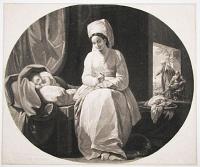
The Golden Age.
Painted by B. West, Historical Painter to his Majesty. Engraved by V. Green, Engraver to his Majesty, and to the Elector Palatine.
Publish'd by J. Boydell, Engraver in Cheapside, June 4.th 1777.
Mezzotint. Platemark: 475 x 570mm (18¾ x 22¼"). Thread margins. Light creasing and rubbing to surface.
A domestic scene in a stylised Eastern setting. A mother is seen sitting to the front and sewing, watching her sleeping young child beside her. A cat sits in a basket below. An elderly couple, the man seated, are in the doorway to the right with a dog. A rural landscape can be seen beyond. Within an oval. For a pair, 'The Golden Age [&] The Silver Age', see item ref: 29074. CS 159. Whitman: 203. Ex Collection: The Late Honourable Christopher Lennox-Boyd.
[Ref: 36646] £450.00
![Hannibal [in image].](img-thumbnail/jpegs/14831.jpg)
Hannibal [in image]. Done from the Original Picture in the Possession of his Majesty.
B. West Pinxit, 1770. V. Green Fecit 1773.
Published Novr. 1st 1773 by Boydell Cheapside. J Boydell excudit. [All inscriptions to foreground steps.]
Mezzotint with hand colouring, sheet 625 x 870mm. 24½ x 34¼". Trimmed to image and laid to card. Surface scuffs and scratches.
The boy Hannibal (248 – 183 or 182 BC), Carthaginian military commander, lays his hands on a horse prepared for sacrifice, encouraged by his father who stands behind him pointing up at a statue of a god behind the altar. A Roman standard is trodden under the boy's feet; in a palace surrounded by soldiers, women and children. After Benjamin West (1738 - 1820). Whitman: 176, II of II. Chaloner Smith: undescribed. Ex: Collection of The Hon. C. Lennox-Boyd.
[Ref: 14831] £480.00
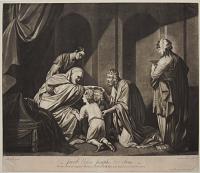
Jacob blesses Josephs two Sons. Done from an Original Picture Painted by Mr. West, in the Possession of Lord Grosvenor.
B. West pinxt. William Wilson fecit.
[n.d., c.1780.]
Rare mezzotint. Sheet 440 x 515mm. Trimmed to image, laid on card.
The elderly Jacob, sitting up on the edge of his bed, leans forward with the help of his attendant and places his hands on the heads of Ephraim, at the front, and Manasseh behind; Joseph, kneeling on the floor facing his father, holds the old man's right hand to attempt to move it to the head of his first born, who he ushers forward. Richard Grosvenor (1731-1802), 1st Earl Grosvenor, was a keen art collector who bought several paintings from Benjamin West, including the famous 'Death of Wolfe'. He also commissioned George Stubbs to paint his 'Arabian' racehorse. Ex: Collection of Hon Christopher Lennox-Boyd.
[Ref: 38191] £320.00
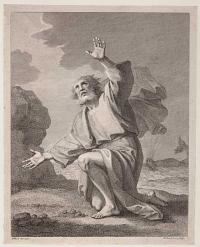
[Jonah an oratorio, Disposed for a voice and harpsicord: composed by Samuel Felsted, organist of St. Andrew's Jamaica.]
B. West inv. 1775. F. Bartolozzi Sculp.
[London, Printed for the Author, by Messrs,, Longman, Lukey & Broderip, No,, 26 , Cheapside, 1775.]
Etching with engraving. Sheet 195 x 155mm (7¾ x 6"). Trimmed, losing title and publication line, laid on album paper.
Jonah on the shore, the whale behind, used as the titlepage to Samuel Felsted' oratorio 'Jonah'. Felstead (1743-1802) was Jamaica's first documented composer, although only two works suvive: his 'Jonah' was the first complete oratorio written in the Americas. De Vesme 1873.
[Ref: 61563] £240.00
(£288.00 incl.VAT)
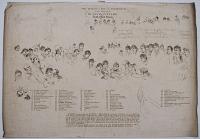
This Outline is a Key to the Portraiture &c. in the Print from Mr West's Picture of the Death of Lord Nelson.
[London, 1811.]
Engraved key plate. 430 x 650mm, 17 x 25½". Creased, edges soiled.
Keyplate of Benjamin West's Death of Lord Nelson, as engraved by James Heath, with a 68-point key and short description of West's intentions with the painting. From the Reference Library of the Parker Gallery.
[Ref: 22803] £260.00
(£312.00 incl.VAT)
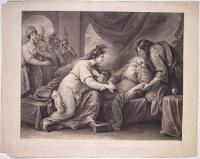
Shakspeare, King Lear Act V Scene I.
Paind by B. West Esqr. R.A. Prest of the Royal Academy & Historical Painter to His Majesty. Engrad by R. Earlom.
Published Jany 1 1799 by B B Evans in the Poultry London.
Mezzotint, 483 x 582mm. Age toning, stain spots lower edge of image. Small tears to tatty margins. Faint crease through upper left corner of image.
The King sits up weakly on his bed, supported by a male figure (perhaps Kent or the Doctor), and with Cordelia sitting beside him, holding his hand and with tears in her eyes. Two further women and two soldiers stand at the left. The scene is in fact incorrectly identified in the title, as the action portrayed here is loosely based on act IV, scene VII. 'Shakspeare' in open letters, very rare. BM: 1838,0714.92. Wessely: undescribed.
[Ref: 8082] £460.00
![[Battle of La Hogue] To the Right Honourable the Lord Grosvenor, This Plate engraved from a Picture of The Battle of La Hogue](img-thumbnail/jpegs/54701.jpg)
[Battle of La Hogue] To the Right Honourable the Lord Grosvenor, This Plate engraved from a Picture of The Battle of La Hogue in his Lordship's Collection is dedicated By His Lordship's much obliged and most obedient humble Servants - Benjamin West and William Woollett.
Painted by B. West, Historical Painter to His Majesty. Engraved by W. Woollett, Engraver to His Majesty.
Published as the Act directs, 18 Oct.r 1781 by B. West, W. Woollett & J. Hall, London.
Etching, fine impression. 490 x 615mm (19¼ x 24¼"). Repaired tears in title area, margins with folds and chips.
The Battle of La Hogue, 3-4th June 1692, during the Nine Years' War, in which the remains of a French fleet transporting an invasion force to England was attacked by an Anglo-Dutch force in longboats. All twelve French ships were destroyed. This plate shows the bitter hand to hand fighting. BM S,1.58, second published state, with the addition of 'Historical Painter to His Majesty'; Fagen 114.
[Ref: 54701] £420.00
![Una. [Mary Lawrence.]](img-thumbnail/jpegs/14770.jpg)
Una. [Mary Lawrence.] From Spencer's Fairy Queen Book 1st. Canto 3. Vers. 4 & 5.
Benjn. West pinxt. R Earlom Sculpt.
Publish'd August 10th. 1772. by J. Boydell Engraver in Cheapside London.
Mezzotint, 470 x 580mm. 18½ x 22¾". Scuff to mezzotint surface around sitter's face.
Portrait of Mary Lawrence (1749 - c.1830) as Una, reclining on the ground within a wood, a beam of light from upper left landing on her head. She wears classical dress, leaning on her right elbow and twisting her long hair with her right hand; a lion at right and donkey either side, landscape with hill and sea beyond. Lawrence was a flower painter and watercolourist, wife of Richard J Lawrence of Jamaica. She exhibited at the RA 1794 - 1830 (after 1813 as Mrs. Kearse). In Edmund Spenser's (1552? - 1599) epic poem 'The Faerie Queene', Una was the wife of Finnbheara, king of the Irish fairies. After Benjamin West (1738 - 1820). Chaloner Smith: 19.: ii of ii Wessely: 32. Ex: Collection of The Hon. C. Lennox-Boyd.
[Ref: 14770] £580.00
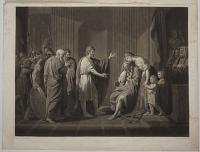
Leonidas.
Painted by Benj.n West, Esqr. Engrav'd by C.H. Hodges.
Publish'd May 1st. 1789, by John & Josiah Boydell, No. 90, Cheapside, London.
Engraving with etching, rare. 495 x 600mm (19½ x 23½"),, with tissue cover as issued. Narrow margins top and bottom, as issued, damp stain on right.
Leonidas II, king of Sparta 254-235 BC, sitting in judgement on his son-in-law Cleombrutus, who had usurped his throne (ruling as Cleonbrutus II, 242-241 BC). Leonidas's daughter pleads for her husband's life, resulting in the pair's banishment. Benhamin West (1738-1820), the Pennsylvanian painter best known for his 'Death of Wolfe', took a story from Plutarch for this painting, which he showed at the second exhibition of the newly-formed Royal Academy, 1768. The painting now resides in the Tate Gallery. Ex: Collection of the Hon. Christopher Lennox-Boyd.
[Ref: 36536] £520.00
![[Orlando Furioso] Angelica and Medoro.](img-thumbnail/jpegs/48178.jpg)
[Orlando Furioso] Angelica and Medoro.
Painted by B. West Historical Painter to his Majesty. Engraved from the Original Picture for Facius.
Publish'd Jan.y 1.st 1778 by John Boydell Engraver in Cheapside London.
Stipple. Sheet: 355 x 265mm (14 x 10½''). Trimmed.
A portrait of lovers Angelica and Medoro, characters in Ludovico Ariosto's 'Orlando Furioso'.
[Ref: 48178] £160.00
(£192.00 incl.VAT)
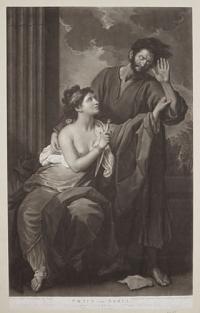
Pætus and Arria. To Her Highness the Princess Daschkau, This Plate is, by Permission, Dedicated, by her Highness's most Dutiful & Obliged, humble Servant, Valentine Green.
Painted by B. West Historical Painter to his Majesty. Engrav'd by V. Green, Mezzotinto Engraver to his Majesty, & the Elector Palatine.
Published [****] No 24 Percy Street Bedford [****].
Mezzotint. Sheet 655 x 405mm (25¾ x 16"). Trimmed within plate, small area of creasing, dedication badly inked, publication line partially erased.
A scene from the letters of Pliny the Younger: Caecina Paetus, having received an order to commit suicide for his part in a rebellion against Emperor Claudius, cannot bring himself to do it. His wife, Arria, stabs herelf and tries to hand her husband the dagger, telling him that it didn't hurt. Pliny heard the story from Arria's granddaughter, Fannia. The scene was engraved by Valentine Green after American painter Benjamin West (1738-1820), and dedicated to Yekaterina Vorontsova-Dashkova (1743-1810), a close friend of Catherine the Great, who was created a Director of the Imperial Academy of Arts and Sciences on her return to Russia in 1782. Originally published by Green in 1781, this is a later state unrecored by Whitman. Whitman: 224. Ex: Collection of The Hon. C. Lennox-Boyd.
[Ref: 48454] £240.00
(£288.00 incl.VAT)
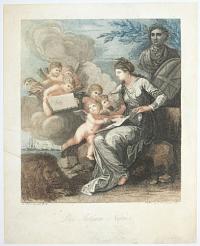
Pax Artium Nutrix.
B. West inv. 1787 R.A. Etched by F. Bartolozzi 1787.
Publish'd in the Act Jany. 28 1787 by Greenwood.
Colour-printed stipple. Sheet: 285 x 230mm (11¼ x 9''). Trimmed within plate, repaired tears, publication line faint.
A woman seated on a rock, wearing the emblems of the three arts on her belt, in front of her are six putti, writing, carrying books and sheets of paper inscribed 'Italy'. On the left, the lion of Britannia and on the right, a bust of King George III, and the shield of Brtiannia; in the background are ships at sea. Frontispiece to "A Catalogue of that superb and well known Cabinet of Drawings of John Barnard Esq., which will be sold by auction by Mr. Greenwood on Friday, Feb. 16. 1787". De Vesme: 553 II.
[Ref: 48990] £140.00
(£168.00 incl.VAT)
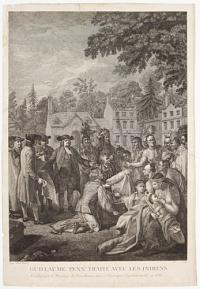
Guillaume Penn Traite avec les Indiens Etablissant la Province de Pensilvanie dans l'Amerique Septentrionale en 1681.
Benj: West Pinxit. D* sculp
[n.d., c.1780]
Engraving, rich impression; sheet 480 x 330mm (18¾ x 13"). Trimmed inside platemark; vertical crease through middle; small tears to edges; hole in centre; laid on conservation tissue.
William Penn's (1644 - 1718) 'Great Treaty' reputedly signed with Delaware Indian leaders in 1682 under an ancient elm tree at the village of Shackamaxon, located in what are now the borders of the city of Philadelphia, Pennsylvania. The event was painted by the Pennsylvania-born artist Benjamin West, a picture which was engraved in 1775. This French copy, probably made from that engraving, reverses and crops the picture to focus upon the centre of West's composition. Ex: Collection of The Hon. Christopher Lennox-Boyd.
[Ref: 31858] £360.00
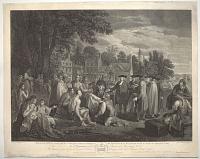
William Penn's Treaty with the Indians, when he founded the Province of Pensylvania in North America 1681. To the Proprietaries of the Province of Pensylvania, &c. &c. This Print, Engraved from the Original Painting belonging to the late Thomas Penn Esquire, Is respectfully Inscribed by Their obedient humble Servant John Boydell.
Benj: West pinxit. John Hall sculpsit.
Published, June 12th. 1775 by John Boydell Engraver in Cheapside London.
Engraving. 485 x 615mm (19 x 24¼"). Repairs to edges.
William Penn's (1644 - 1718) 'Great Treaty' was reputedly signed with Delaware Indian leaders in 1682 under an ancient elm tree at the village of Shackamaxon, located in what are now the borders of the city of Philadelphia, Pennsylvania. This highly detailed depiction of the event, shows Penn in the centre left, with his arms open, his entourage beside him, two of his men kneeling, offering gifts to the Indians who are assembled at the right. Buildings in construction can be seen behind at the left, with boats on the sea at right. The painting by Benjamin West (1738 - 1820), who was born in Pennsylvania, is now in the Pennsylvania Academy of the Fine Arts. West was the first American-born artist to receive international recognition and remains one of the most important eighteenth-century painters of historical scenes. He enjoyed a career that endured more than half a century that included serving as president of the Royal Academy. William Penn, quaker leader and founder of Pennsylvania, was the first great hero of American liberty. During the late seventeenth century, Penn established an American sanctuary which protected freedom of conscience. Almost everywhere else, colonists stole land from the Indians, but Penn travelled unarmed among the Indians and negotiated peaceful purchases. He insisted that women deserved equal rights with men. He gave Pennsylvania a written constitution which limited the power of government, provided a humane penal code, and guaranteed many fundamental liberties. For the first time in modern history, a large society offered equal rights to people of different races and religions. Penn's dramatic example caused quite a stir in Europe. The French philosopher Voltaire, a champion of religious toleration, offered lavish praise. 'William Penn might, with reason, boast of having brought down upon earth the Golden Age, which in all probability, never had any real existence but in his dominions'.
[Ref: 54272] £690.00
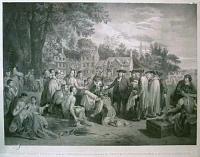
William Penn's Treaty with the Indians, when he founded the Province of Pensylvania in North America.
[after Benjamin West.]
[n.d., c.1840.]`
Lithograph, 13½ x 17".
Penn was born October 14, 1644 to Anglican parents, Admiral Sir William Penn and Margaret Jasper. For much of his young life he knocked about, getting expelled from Oxford, learning law at Lincoln's Inn, studying in the Huguenot Academy at Saumer, and managing his father's estates in Ireland. Soon after hearing the famous apostle Thomas Loe, he converted to Quakerism. Then in his mid twenties, he quickly involved himself in the Quaker cause, landing in prison several times for his 'radical' preaching for personal, property, and religious rights. In 1672 he married Gulielma Maria Springett, and five years later traveled in the company of George Fox to Holland. Penn, though wealthy and though a Quaker, lived beyond his means. In order to raise some funds he called in a debt owed his father by Charles II. On March 4, 1681 he obtained the charter for Pennsylvania, [and in August 1682 he gained the rights to Delaware from his friend James, the Duke of York.] Penn planned to make money by selling tracts of land, and although he was able to attract a good number of investors he never realized the profit he imagined. However, he saw this venture as more than a money-making exercise; it was, in his famous words to his friend and land agent for Pennsylvania, James Harrison, a "holy experiment." This experiment would become, as he confidently predicted, "the seed of a nation.". Penn imagined a "free. .sober and industrious people" living by their own laws. In 1682 he sought to delineate these laws in the First Frame of government; and though somewhat less liberal than his New Jersey bill, it provided many of the same rights. Penn first arrived at his new colony in the fall of 1682 and stayed only until August of 1684. It was at this time that he supposedly signed his famous treaty with the Delaware (Leni Lenape) at Shackamaxon. And though no copy of such an agreement exists, we do have a wampum belt allegedly given to Penn by the Indians. The first treaty document in existence is one dated July 15, 1682 in which Penn obtains land from Idquahon and several other Leni Lenape leaders. In the next year Penn would broker at least eight other land transactions with the Delaware. He was busy with man other tasks as well. During his first stay, Penn began building his mansion and attending to numerous details of colony building, including a border dispute with Lord Baltimore, who controlled the territory south of Pennsylvania. He returned to England to continue his dispute with Baltimore, not to return to Pennsylvania until 1699. The England in the 1690s was a tumultuous place, especially for an outspoken, liberal Quaker. Penn never shirked from the political fray, as did many of his fellow Quakers, though his forthrightness proved dangerous. He supported James II, though in the Glorious Revolution of 1688 William and Mary bested James. Later, under suspicion of treason, Penn briefly lost control of his colony from 1692 to 1694. He received another setback when his wife died in 1694, though he rebounded by remarrying a year and a half later to Hannah Callowhill. Back in Pennsylvania, political squabbling had set in and various leadership changes took place. In 1691 George Keith led a religious schism, and Pennsylvania and Delaware separated into two provinces. And in 1696, William Markham's (Penn's secretary and then governor of Delaware) charter replaced the earlier 'Frame', though when Penn returned in 1701 he would again revise this version. By the time he left for good in November of that year, the colony's Assembly was elected yearly and enjoyed a more powerful position than the governor, who despite his veto power, was secondary to the legislative body. Though Penn planned to stay in the New World, settling at his manor Pennsbury, (up the Delaware from Philadelphia) but further political troubles in England forced his return, and in 1712 suffered an attack of apoplexy which disabled him. His wife Hannah managed his affairs until Penn died in 1718, and after her death ion 1727 the proprietorship of Pennsylvania passed to their sons, John, Thomas, and Richard.
[Ref: 6523] £420.00
![[The Angel]](img-thumbnail/jpegs/36698.jpg)
[The Angel] [He is not here: for he is risen. &c.]
B. West 1801
[first published 1803]
Pen lithograph, sheet 315 x 225mm (12½ x 9"). Glued to backing sheet; trimmed, losing text below image. Unidentified collector's stamp verso.
Text from Matthew 28:6, in which the angel of the resurrection directs women looking for the crucified Jesus to 'see the place where He was lying'. A landmark in the history of lithograph, this original print by Benjamin West has been described as 'the first lithograph of artistic merit ever done in any country' (Felix Man). It was published as one of the twelve pen lithographs from 'Specimens of Polyautography', the first set of artist's lithographs ever published (by Philipp André in 1803). The new medium allowed artists to draw directly onto a prepared stone, allowing artists to make prints which arguably resembled drawings more than any earlier printmaking technique. Unlike many printmaking techniques, lithography required no special training as artists could work directly onto the plate and leave specialist printers to actually make the prints. For this reason many painters who were not trained printmakers (such as Géricault and Delacroix) produced lithographs. West (1738-1820) was an Anglo-American painter of historical scenes around and after the time of the American War of Independence. He was the second president of the Royal Academy in London, serving from 1792 to 1805 and again from 1806 until his death. Ex: collection of the late Hon. C. Lennox-Boyd; Man, '150 Years of Artists' Lithographs', cat. 1.
[Ref: 36698] £2,200.00
view all images for this item

The Death of General Wolfe at Quebec.
Painted by B. West. Engraved by de Launay.
London Published by Tessari & Co. [n.d., c.1790.]
Stipple and etching with small margins. Platemark: 325 x 400mm (12¾ x 15¾"). Repaired tear in lower margin. Light foxing in margins.
General James Wolfe (1727-59), killed at the moment of his famous victory over the French at Quebec, which delivered Canada into the hands of the British. Wolfe, supported by three grenadiers, succumbs to his fatal wounds, watched by nine other officers and a native American warrior to the left. After Pennsylvanian painter Benjamin West (1738 - 1820). West moved to London in 1763, where he remained, becoming President of the Royal Academy.
[Ref: 35771] £530.00
![[To the King's most excellent Majesty, This plate, The Death of General Wolfe.]](img-thumbnail/jpegs/39487.jpg)
[To the King's most excellent Majesty, This plate, The Death of General Wolfe.]
[Painted by B. West, Historical Painter to His Majesty. Engraved by Theod. Falkerysen.]
[n.d., c.1780.]
Engraving. Proof working impression. Sheet size: 430 x 585mm (17 x 23"). Trimmed to image. Glued to backing sheet with ink borders.
A working proof impression by Theodore Falkeysen of Benjamin West's most celebrated painting, 'The Death of General Wolfe', 1770 (Ottawa, National Gallery of Canada), which represents the death of the British General James Wolfe at the Battle of the Plains of Abraham outside Quebec in 1759 during the Seven Years' War. Despite Wolfe's death, the result of the battle was a decisive British victory. For a completed impression by Falkeysen, see item ref: 39485.
[Ref: 39487] £520.00

To the King's most excellent Majesty, This plate, The Death of General Wolfe, is with His gracious Permission humbly dedicated by his Majesty's most dutiful Subject, William Woollett. From the original Picture in the Collection of the Right honourable Lord Grosvenor.
Painted by B. West, Historical Painter to His Majesty. Engraved by W.m Woollett, Engraver to his Majesty.
Published as the Act directs January 1.st 1776. by Mess.rs Woollett, Boydell & Ryland, London.
Engraving. 490 x 620mm (19¼ x 24¼"), with narrow margins.
Large engraving of Benjamin West's famous painting of 1770 (Ottawa, National Gallery of Canada) representing the death of the British General James Wolfe at the Battle of the Plains of Abraham in 1759 during the Seven Years' War. Despite Wolfe's death, the result of the battle was a decisive British victory. West's composition deliberately evokes the Lamentation of Christ, a subject frequently depicted in religious painting. Fagan XCIII x/x.
[Ref: 33190] £780.00
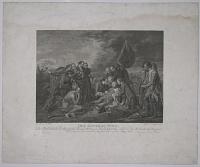
Der General Wolf, Ober Befehlshaber des Englischen Kriegs-Heeres in Nord Amerika, ward in der Schlacht bei Guebeck den 13. September 1759. verwundet, und Starb in dem er Seinen Sieg erfuhr.
Gemacht von B. West Gegraben von Carl Guttenberg.
[...]berg bei D.A. Hauer; à Paris chez Guttenberg Rue St. Hiacinthe prè la Place St. Michel. [n.d., c.1772]
Copper engraving, 240 x 295mm. 9½ x 11½". Paper discoloration.
German engraving of Benjamin West's painting depicting the death of the British General James Wolfe in the Battle of Quebec, 1759. The painting is now in the National Gallery of Canada, Ottawa.
[Ref: 11244] £180.00
(£216.00 incl.VAT)
![[Lydia Sterne de Medalle.]](img-thumbnail/jpegs/58662.jpg)
[Lydia Sterne de Medalle.]
[Painted] by B. West. Engraved by S. Cald[wall].
[Publish'd by T Becket according to Act of Parliament August 10th 1775.]
Engraving. Sheet 130 x 80mm (5 x 3¼"). Trimmed to image and around title, losing part of artist & engraver's signatures and all of the publication line.
A portrait of Laurence Sterne's daughter Lydia (1747-80), posed with a bust of her father, the frontispiece to her edition of his 'Letters'.
[Ref: 58662] £60.00
(£72.00 incl.VAT)
![[The Death of the Chevalier Bayard.]](img-thumbnail/jpegs/51163.jpg)
[The Death of the Chevalier Bayard.]
B. West Pinxit. V. Green (Mezzotinto Engraver to his Majesty) Fecit.
Published by J. Boydell, Cheapside, Feb.y 1 1774.
Fine and rare mezzotint. 635 x 520mm (25 x 20½"). Slight stain at bottom. Small margins.
A dramatic scene of the death Pierre Terrail, seigneur de Bayard (1473-1524), in armour, leaning against a tree on the battlefield, attended by his opponent, Charles, duc de Bourbon. An illustrious career fighting for the French (including at the Battle of the Spurs, 1513, against Henry VIII), gave Terrail the nickname 'le chevalier sans peur et sans reproche' (the knight without fear and beyond reproach). However his death came at the end of the age of chivalry: his armour did not protect him from an arquebus ball.
[Ref: 51163] £680.00
Unfortunately this item is either sold or reserved. If you are interested in similar items and cannot find what you're looking for on our website, please consider filling in our interests form. If you register, we can also send you items that match your interests when the website is updated.
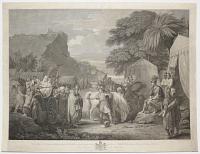
The Distress of Tigranes, before Cyrus, on finding his Father the King of Armenia, Mother, Wife, and Children, Prisoners. In the Collection of his Majesty.
Painted by Benn. West Esqr. 1769. Histl. Painter to his Majesty. Engraved by Jas. Fittler.
Published March 25th. 1788, by John & Josiah Boydell: No. 90 Cheapside London.
Engraving, image 425 x 590mm. 16¾ x 23¼". Lacking margins, and trimmed close to image on three sides, laid down.
An imaginatively reconstructed scene from antiquity: Tigranes stands in the centre of a camp beside his horse, waving his fist angrily in the direction of his father, who stands with head bowed before the carriage in which the rest of his family sit; Cyrus the Great (c.590/80 BC - 530 BC), ruler of the Persian empire listens, seated on a rock at the entrance of his tent at right, his soldiers and advisors surrounding; cliffs and sea in background. Royal coat of arms below image. After Benjamin West (1738 - 1820).
[Ref: 23929] £260.00
(£312.00 incl.VAT)
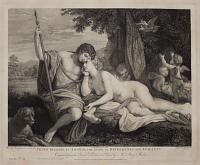
Venus Relating to Adonis, the Story of he Hippomenes and Atalanta. Engraved from the Original Picture; Painted by Mr. Benjn. West. Size of the picture 5F, 4I by 7F, 2I in Length. Vol. II. No.51.
Benjn. West pinxit. R. Earlom delint. John Boydell excudit 1769. John Hall Sculpsit.
Published according to Act of Parliam.t Septr. 1.st 1769. by J. Boydell Engraver, in Cheapside London.
Very fine engraving, paper watermarked. Plate 431 x 532mm (17 x 21").
Venus and Adonis, the goddess reclining on the ground with her head resting on his breast, relating the story of Hippomenes and Atalanta; the hunter's lion sits on the ground at left, cupids play with two doves behind to right. Ex Collection Duke of Westminster.
[Ref: 38180] £520.00
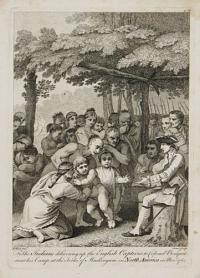
The Indians delivering up the English Captives to Colonel Bouquet near his Camp at the Forks of Muskingum in North America in Nov.r 1764
B. West inv.t. Canot Sculp.
Etching, platemark 230 x 160mm (9 x 6¼"). Large margins.
Engraving after Benjamin West, American-born artist who became President of the Royal Academy. This etching was published in William Smith's 'Historical Account of the Expedition against the Ohio Indians' (1766). Bouquet (1719-65) was successful in striking against the Ohio tribes, and the Shawanese and Delaware sued for terms. Bouquet was made brigadier-general and commandant of all troops in British America's southern colonies, but he died soon after. West's original drawing, dated 1765, is in the Yale Centre for British Art.
[Ref: 37097] £280.00
(£336.00 incl.VAT)
![[Agriculture.]](img-thumbnail/jpegs/50428.jpg)



![[Apollo calling up the Fine Arts and Sciences.]](img-thumbnail/jpegs/50427.jpg)
![[Annonce de T. Sandby.]](img-thumbnail/jpegs/20501.jpg)



![[Battle of the Boyne.] To His Royal Highness George Prince of Wales, This Plate engraved from the original Picture of The Battle of the Boyne,](img-thumbnail/jpegs/54702.jpg)

![[St Cecilia.]](img-thumbnail/jpegs/20481.jpg)








![[Fidelia and Spiranza.]](img-thumbnail/jpegs/14754.jpg)
![George III. King of Great Britain. &c. &c. [&] Charlotte. Queen of Great Britain. &c. &c.](img-thumbnail/jpegs/36317.jpg)

![The Golden Age. [&] The Silver Age.](img-thumbnail/jpegs/29074.jpg)


![Hannibal [in image].](img-thumbnail/jpegs/14831.jpg)




![[Battle of La Hogue] To the Right Honourable the Lord Grosvenor, This Plate engraved from a Picture of The Battle of La Hogue](img-thumbnail/jpegs/54701.jpg)
![Una. [Mary Lawrence.]](img-thumbnail/jpegs/14770.jpg)

![[Orlando Furioso] Angelica and Medoro.](img-thumbnail/jpegs/48178.jpg)





![[The Angel]](img-thumbnail/jpegs/36698.jpg)

![[To the King's most excellent Majesty, This plate, The Death of General Wolfe.]](img-thumbnail/jpegs/39487.jpg)


![[Lydia Sterne de Medalle.]](img-thumbnail/jpegs/58662.jpg)
![[The Death of the Chevalier Bayard.]](img-thumbnail/jpegs/51163.jpg)


